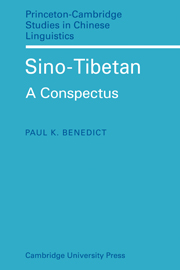Book contents
- Frontmatter
- Foreword
- Contents
- Preface
- Abbreviations
- 1 Introduction
- 2 Taxonomy (general)
- 3 Taxonomy (Sino-Tibetan)
- 4 Tibeto-Burman classification
- 5 Tibeto-Burman reconstruction (history)
- 6 Tibeto-Burman primary sources
- 7 Tibeto-Burman consonants (general; final)
- 8 Tibeto-Burman consonants (initial)
- 9 Tibeto-Burman consonant clusters
- 10 Tibeto-Burman vowels (finals; diphthongs)
- 11 Tibeto-Burman vowels (medials)
- 12 Tibeto-Burman tones
- 13 Tibeto-Burman morphology (history)
- 14 Tibeto-Burman morphology (categories)
- 15 Tibeto-Burman pronouns
- 16 Tibeto-Burman numerals
- 17 Tibeto-Burman morphology and syntax (general)
- 18 Tibeto-Burman affixes (special)
- 19 Tibeto-Burman affixes (general)
- 20 Tibeto-Burman dental suffixes
- 21 Tibeto-Burman prefixes (general)
- 22 Tibeto-Burman prefixed *s-
- 23 Tibeto-Burman prefixed *r-
- 24 Tibeto-Burman prefixed *b-
- 25 Tibeto-Burman prefixed *g-
- 26 Tibeto-Burman prefixed *d-
- 27 Tibeto-Burman prefixed *m-
- 28 Tibeto-Burman prefixed *a-
- 29 Tibeto-Burman alternation (consonantal, vocalic)
- 30 Karen (general)
- 31 Karen morphology (categories) and syntax
- 32 Karen pronouns
- 33 Karen numerals
- 34 Karen prefixes
- 35 Karen initial consonants and clusters
- 36 Karen final consonants and medial vowels
- 37 Karen final vowels and semi-vowels
- 38 Karen tones
- 39 Chinese (general, history)
- 40 Chinese morphology (prefixes, suffixes, alternation)
- 41 Chinese pronouns
- 42 Chinese numerals
- 43 Chinese phonology (history)
- 44 Chinese consonants (initials, finals)
- 45 Chinese consonant clusters
- 46 Chinese vowels and diphthongs
- 47 Chinese tones
- 48 Résumé (Chinese)
- Appendix I Tibeto-Burman roots
- Appendix II English–TB index
- Appendix III Primary Tibeto-Burman sources
- Appendix IV Author's and editor's bibliography
27 - Tibeto-Burman prefixed *m-
Published online by Cambridge University Press: 10 November 2010
- Frontmatter
- Foreword
- Contents
- Preface
- Abbreviations
- 1 Introduction
- 2 Taxonomy (general)
- 3 Taxonomy (Sino-Tibetan)
- 4 Tibeto-Burman classification
- 5 Tibeto-Burman reconstruction (history)
- 6 Tibeto-Burman primary sources
- 7 Tibeto-Burman consonants (general; final)
- 8 Tibeto-Burman consonants (initial)
- 9 Tibeto-Burman consonant clusters
- 10 Tibeto-Burman vowels (finals; diphthongs)
- 11 Tibeto-Burman vowels (medials)
- 12 Tibeto-Burman tones
- 13 Tibeto-Burman morphology (history)
- 14 Tibeto-Burman morphology (categories)
- 15 Tibeto-Burman pronouns
- 16 Tibeto-Burman numerals
- 17 Tibeto-Burman morphology and syntax (general)
- 18 Tibeto-Burman affixes (special)
- 19 Tibeto-Burman affixes (general)
- 20 Tibeto-Burman dental suffixes
- 21 Tibeto-Burman prefixes (general)
- 22 Tibeto-Burman prefixed *s-
- 23 Tibeto-Burman prefixed *r-
- 24 Tibeto-Burman prefixed *b-
- 25 Tibeto-Burman prefixed *g-
- 26 Tibeto-Burman prefixed *d-
- 27 Tibeto-Burman prefixed *m-
- 28 Tibeto-Burman prefixed *a-
- 29 Tibeto-Burman alternation (consonantal, vocalic)
- 30 Karen (general)
- 31 Karen morphology (categories) and syntax
- 32 Karen pronouns
- 33 Karen numerals
- 34 Karen prefixes
- 35 Karen initial consonants and clusters
- 36 Karen final consonants and medial vowels
- 37 Karen final vowels and semi-vowels
- 38 Karen tones
- 39 Chinese (general, history)
- 40 Chinese morphology (prefixes, suffixes, alternation)
- 41 Chinese pronouns
- 42 Chinese numerals
- 43 Chinese phonology (history)
- 44 Chinese consonants (initials, finals)
- 45 Chinese consonant clusters
- 46 Chinese vowels and diphthongs
- 47 Chinese tones
- 48 Résumé (Chinese)
- Appendix I Tibeto-Burman roots
- Appendix II English–TB index
- Appendix III Primary Tibeto-Burman sources
- Appendix IV Author's and editor's bibliography
Summary
TB prefixed *m- is more readily interpreted than the stop prefixes analyzed above. With verb roots this prefix has a ‘middle voice’ force, often durative, intransitive, or reflexive. Tibetan m-, as brilliantly interpreted by Wolfenden, represents a ‘neuter’ subject, as opposed to b- andʾ-representing an ‘acting’ subject; cf. mguba ‘rejoice’, mŋa-ba ‘to be, exist’, mnal-ba ‘to sleep’, mtśhi-ba ‘appear, show oneself’, mnab-pa ‘dress oneself’. Prefixed *m- in this role is retained also in Kachin, Bodo-Garo and Kuki-Naga, while Nung replaces this prefix with phǝ-<*bǝ-: phǝsin ‘liver’ <TB *m-sin, phǝlε ‘tongue’ <TB *m-lay. The contrast with TB prefixed *s- is especially clear in the following root; note that the unprefixed root may be either transitive or intransitive, whereas the prefixed *m- form is always intransitive:
(464) T mnam-pa ‘to smell, stink’ (intr.), snam-pa∼snom-pa∼snum-pa ‘to smell’ (tr.), Lepcha nom<*nam ‘to smell’ (intr.), nyom<*s-nam (tr.); Vayu nam ‘to smell’ (tr.), nam-saŋ ‘odor’; Bahing nam ‘to smell’ (tr.), nam-ba ‘having odor’; Miri nam ‘to smell’ (tr.); K nam ‘to taste or smell, as of spices’, mǝnam ‘to smell; smell, scent’ (mǝnam nam ‘to smell offensively’); Nung phǝnam ‘to smell’ (use uncertain); B nam ‘smell offensively, stink’ (intr.), nàm ‘smell, receive scent’ (tr.), ӑnám ‘odor’; Bodo manam ‘to smell’ (intr.); Dimasa maram ‘to stink’ (n<*r through dissimilation); L nam, Ao Naga menem ‘to smell’ (intr.); Tangkhul η∂nam ‘odor’, kh∂η∂nam ‘to smell’ (intr.); Mikir iηnim ‘to smell, be odorous’ (intr.), aηnim ‘odor’, nem-so ‘slight smell, stink’ (-so is diminutive), from TB *m-nam.
- Type
- Chapter
- Information
- Sino-TibetanA Conspectus, pp. 117 - 121Publisher: Cambridge University PressPrint publication year: 1972



